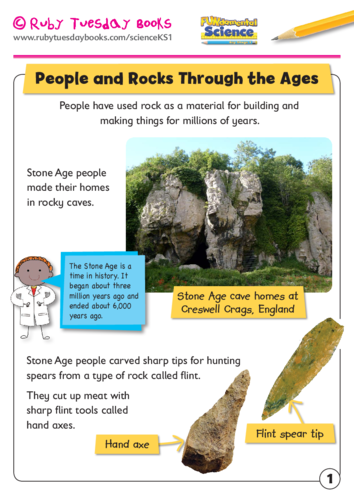
KS1 Science: Materials - People and rocks through the ages
Use these information sheets to discuss a range of rocks through the ages. Great cross curricular text for Stone Age study and geography. Includes a real range of buildings to look at and compare: stone age art; Stonehenge; the Pyramids in Egypt; a temple at Petra; the Taj Mahal; the Palace of Westminster and Mount Rushmore. Why not plot these on your class world map to include cross curricular geography links? It complements our book ‘Everyday materials’ from our FUNdamental Science series. For more information, downloads and to purchase our books, please visit www.rubytuesdaybooks.com
This download helps meet the following National Curriculum targets:
Year 1 Science: Everyday materials
Statutory:
Distinguish between an object and the material from which it is made
Identify and name a variety of everyday materials, including wood, plastic, glass, metal, water, and rock
Compare and group together a variety of everyday materials on the basis of their simple physical properties.
Notes and guidance (non-statutory)
Pupils should explore, name, discuss and raise and answer questions about everyday materials so that they become familiar with the names of materials and properties such as: hard/soft; stretchy/stiff; shiny/dull; rough/smooth; bendy/not bendy; waterproof/not waterproof; absorbent/not absorbent; opaque/transparent. Pupils should explore and experiment with a wide variety of materials, not only those listed in the programme of study, but including for example: brick, paper, fabrics, elastic, foil.
Year 2 Science: Uses of everyday materials
Statutory:
Identify and compare the suitability of a variety of everyday materials, including wood, metal, plastic, glass, brick, rock, paper and cardboard for particular uses
Find out how the shapes of solid objects made from some materials can be changed by squashing, bending, twisting and stretching.
Notes and guidance (non-statutory):
Pupils should identify and discuss the uses of different everyday materials so that they become familiar with how some materials are used for more than one thing (metal can be used for coins, cans, cars and table legs; wood can be used for matches, floors, and telegraph poles) or different materials are used for the same thing (spoons can be made from plastic, wood, metal, but not normally from glass). They should think about the properties of materials that make them suitable or unsuitable for particular purposes and they should be encouraged to think about unusual and creative uses for everyday materials.
Pupils might work scientifically by: comparing the uses of everyday materials in and around the school with materials found in other places (at home, the journey to school, on visits, and in stories, rhymes and songs); observing closely, identifying and classifying the uses of different materials, and recording their observations.
Something went wrong, please try again later.
This resource hasn't been reviewed yet
To ensure quality for our reviews, only customers who have downloaded this resource can review it
Report this resourceto let us know if it violates our terms and conditions.
Our customer service team will review your report and will be in touch.
